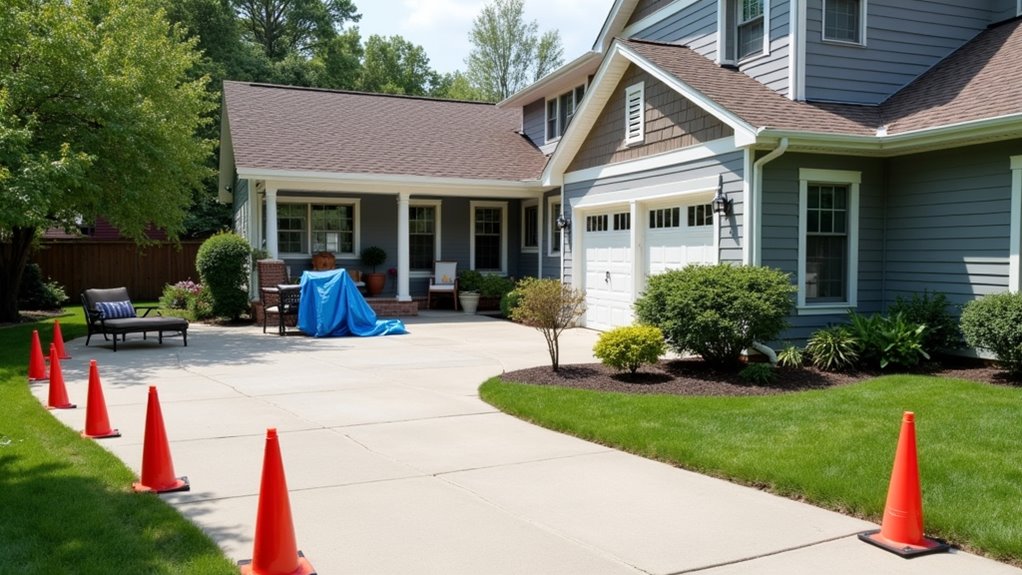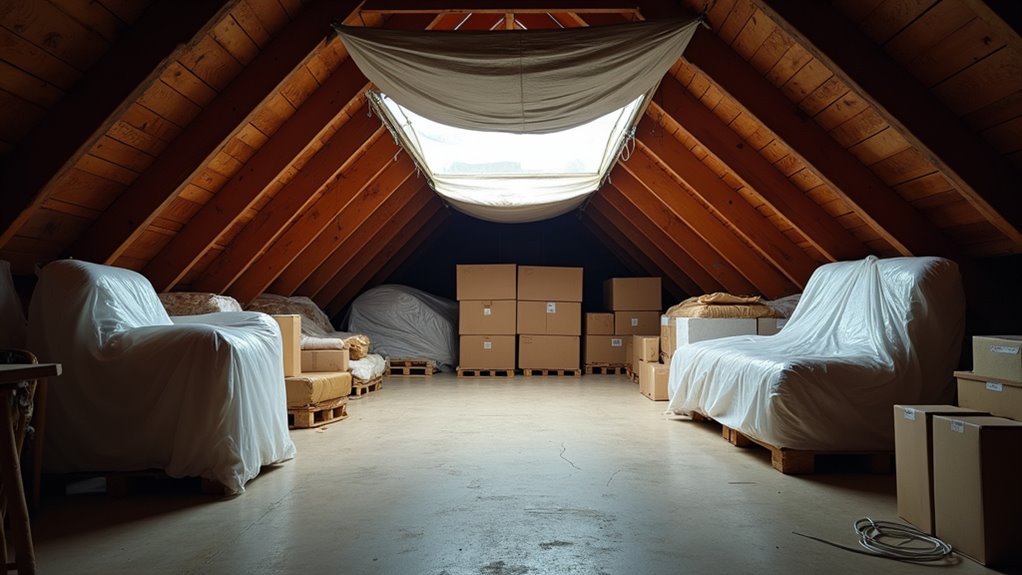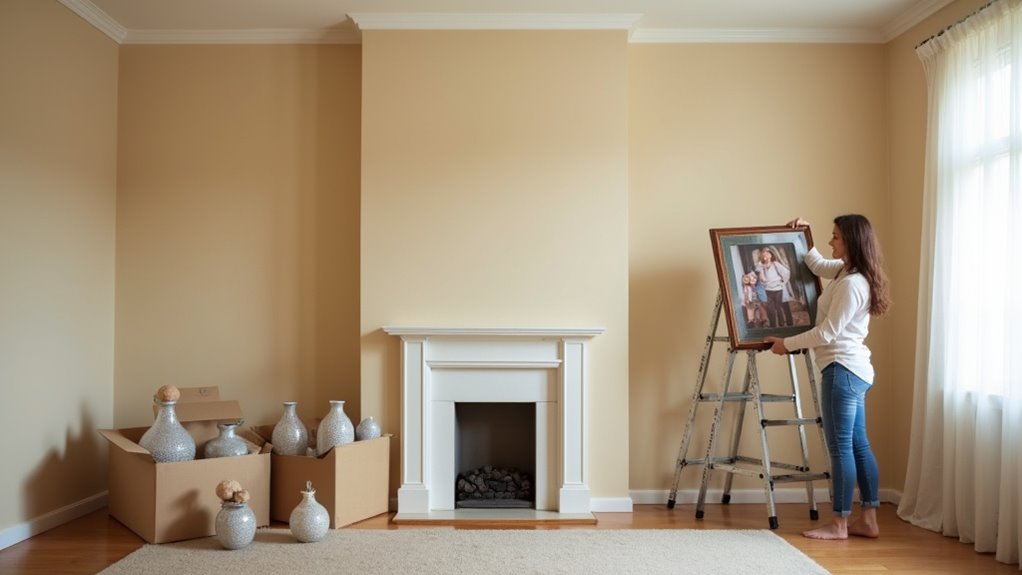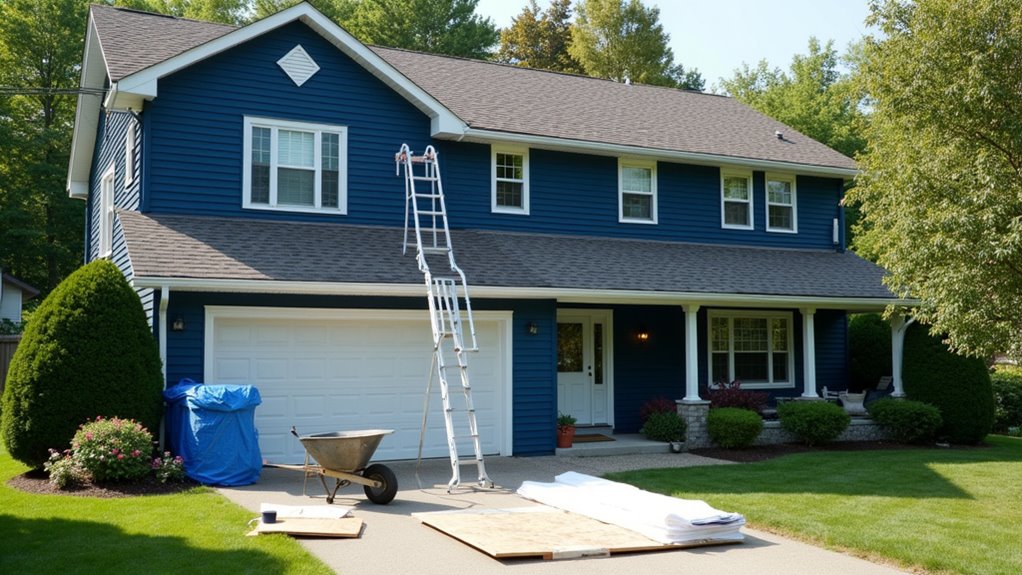Before starting your roof replacement, you’ll need to protect your property inside and out. Clear your yard of furniture, vehicles, and debris, moving everything at least 20 feet from your home’s perimeter. Cover your attic contents with heavy-duty tarps, remove wall decorations, and protect landscaping with plywood sheets. Inform neighbors about the project timeline, and create clear access paths for workers. These essential preparations will guarantee a smooth, damage-free roofing project.
Clear Your Yard and Outdoor Space

Before your roofing contractors arrive, remove all outdoor furniture, planters, grills, and decorative items from your yard and immediate surroundings. Move these items at least 20 feet away from your home’s perimeter to protect them from falling debris and create a safe work zone for the crew.
Clear all yard debris and outdoor tools from your property, including rakes, shovels, and garden equipment. If you have a garage or shed, store valuable items inside to prevent damage. Remember to relocate vehicles from your driveway and trim overhanging tree branches that might interfere with the roofing work. Cover your swimming pool, if applicable, and protect delicate plants with tarps. These precautions will help guarantee a smooth, efficient roof replacement while safeguarding your property from potential damage during construction.
Protect Your Attic and Valuables

Before your roof replacement begins, you’ll need to remove valuable items and storage boxes from your attic space to protect them from construction debris and potential water damage. Make sure to cover any remaining items with heavy-duty tarps or plastic sheeting to shield them from falling dust and roofing materials. To prevent damage from vibrations during the replacement work, it is crucial to take down pictures, mirrors, and other wall decorations from the upper floors of your home.
Clear Out Storage Items
Protecting valuables stored in your attic requires immediate attention when preparing for a roof replacement. Before the contractors arrive, implement proper storage organization and item categorization to safeguard your belongings from dust, debris, and potential damage.
Take these essential steps to secure your stored items:
- Remove all items from areas directly beneath the roof work zone, including boxes, furniture, and seasonal decorations – even if they’re covered
- Transfer sensitive materials like photos, documents, and electronics to a climate-controlled space on your ground floor
- Label and inventory any items you relocate to guarantee nothing gets misplaced during the renovation process
Don’t underestimate the amount of vibration and dust that can infiltrate your attic during roof replacement. Taking these precautions now will protect your valuables and make the restoration process smoother.
Cover Everything With Tarps
Even after removing items from your attic, you’ll need heavy-duty tarps to shield the remaining structure and any fixed elements from falling debris and dust. During roof replacement, debris can penetrate the smallest openings and damage insulation, wiring, and ventilation systems.
For proper tarp selection, choose thick, waterproof materials rated for construction use. You’ll want tarps large enough to overlap and create complete coverage of your attic space. During tarp installation, secure the edges firmly to prevent shifting and guarantee no gaps remain exposed. Pay special attention to covering electrical junction boxes, HVAC components, and any built-in storage areas.
Don’t forget to extend tarp coverage beyond your attic space to protect walls and floors below. Proper placement will prevent costly repairs and maintain your home’s integrity throughout the roofing project.
Remove Wall Decorations Above
The intense vibrations from roof work can easily dislodge pictures, mirrors, and decorative items mounted on your upper-floor walls. During a roof replacement, constant hammering and equipment movement create strong reverberations that travel through your home’s structure. To protect your wall art and prevent potential damage or injury, you’ll need to take precautionary measures.
- Remove all picture frames, mirrors, and decorative items from walls in upper-floor rooms directly beneath the work area
- Store these items flat in a safe location on your ground floor, preferably wrapped in protective materials
- Check wall-mounted TVs and large mirrors that can’t be easily removed – consider having professionals temporarily dismount them
Don’t wait until the day of installation to secure these items. It’s best to remove wall decorations at least one day before work begins.
Remove Wall Decorations and Fragile Items

During a roof replacement, intense vibrations from hammering and equipment can shake your walls and knock items loose. Take down all wall art, mirrors, and fragile collectibles from your walls and shelves before work begins. Store these items in a safe location away from the construction zone.
| Item Type | Risk Level | Action Required |
|---|---|---|
| Mirrors | High | Remove & Wrap |
| Wall Art | High | Store Flat |
| China | High | Box Securely |
| Vases | Medium | Relocate |
| Photos | Medium | Remove & Store |
Don’t forget to check rooms directly below the roof work area. Remove light fixtures that aren’t securely mounted and relocate antiques or delicate electronics that could be affected by vibrations. This preventive step will protect your valuables from potential damage and give you peace of mind during the renovation process.
Inform Your Neighbors About the Project
Responsible homeowners should notify adjacent neighbors at least one week before their roof replacement begins. Effective neighbor communication helps maintain positive relationships and allows others to prepare for temporary disruptions. Share your project timeline and what they can expect during the renovation.
Key details to discuss with your neighbors:
- Inform them about construction hours, including start and end times each day, and the expected project duration
- Alert them about potential noise, dust, and increased traffic from work crews and delivery vehicles
- Request they temporarily relocate outdoor furniture, grills, or vehicles that could be affected by falling debris or need contractor access
Providing this advance notice demonstrates consideration for your neighbors‘ daily routines and helps prevent conflicts during the renovation process. Consider leaving your contact information for any urgent concerns that may arise.
Create a Safe Path for Workers
Beyond communicating with neighbors, establishing clear access routes for your roofing crew will streamline the project and prevent workplace accidents. Create designated pathways that prioritize worker safety and site accessibility, ensuring crews can efficiently transport materials and equipment.
| Area to Clear | Distance Needed | Safety Consideration |
|---|---|---|
| Driveway | 20 feet | Material delivery zone |
| House perimeter | 6 feet | Equipment staging |
| Entry points | 4 feet | Emergency access |
Remove obstacles like planters, furniture, and decorations from these pathways. Mark underground sprinklers or delicate landscaping features that workers need to avoid. If possible, establish a dedicated space for the dumpster that won’t interfere with crew movement. You’ll also want to trim low-hanging branches that could impede access to your roof or create hazards for workers carrying materials.
Relocate Vehicles and Outdoor Furniture
You’ll need to move all vehicles away from your home’s perimeter and clear your driveway completely to provide essential workspace for roofing crews and material deliveries. Make sure to relocate or securely cover your patio furniture, as falling debris can cause significant damage to tables, chairs, and outdoor accessories. Don’t forget to protect vulnerable garden features and decorative elements by covering them with sturdy tarps or temporarily moving them to a safe location.
Clear Your Driveway Space
When preparing for a roof replacement, clearing your driveway and surrounding areas is essential for ensuring worker access and protecting your property. Your roofing crew needs ample space to position their equipment, set up safety barriers, and establish driveway markings for material delivery trucks and vehicle access.
Follow these critical steps to prepare your driveway space:
- Remove all vehicles, trailers, and portable storage units from your driveway at least 24 hours before work begins
- Create a clear path extending 15 feet from your driveway’s entrance to accommodate large delivery trucks and waste containers
- Mark underground sprinkler systems, delicate landscaping, or hidden obstacles near your driveway to prevent damage from heavy equipment
These preparations will help your roofing project proceed smoothly while protecting your property from potential damage during the renovation process.
Protect Patio Furniture Items
Taking proper precautions with outdoor furniture and vehicles during a roof replacement prevents costly damage from falling debris, nails, and construction materials.
Move all patio furniture, grills, and outdoor decorations at least 15 feet away from your home’s perimeter. If you can’t relocate these items to a secure indoor location, cover them completely with heavy-duty protective tarps. Pay special attention to cushioned furniture, which can be particularly vulnerable to damage from roofing materials and sharp objects.
Don’t rely on standard furniture covers alone – they’re not designed to withstand heavy construction debris. Use thick, puncture-resistant tarps and secure them tightly with bungee cords or rope. For delicate or valuable outdoor items, it’s best to store them in your garage or shed until the roofing project is complete.
Cover Vulnerable Garden Elements
Three key garden areas require protection during a roof replacement: delicate plants, landscaping features, and in-ground irrigation systems. You’ll need to shield these vulnerable elements from falling debris and heavy foot traffic during the project.
Here’s what you need to protect:
- Cover flower beds with lightweight tarps or protective netting, securing them firmly but loosely enough to allow airflow and prevent plant damage
- Shield garden furniture, water features, and decorative elements with heavy-duty drop cloths or move them to a safe distance from the work zone
- Mark all sprinkler heads and irrigation components with bright flags or stakes so workers can avoid stepping on or damaging them
Consider temporarily relocating potted plants and smaller garden accessories to your garage or a covered area until the roof work is complete.
Protect Your Garden and Landscaping
A successful roof replacement requires careful protection of your landscaping and garden areas, as falling debris and worker traffic can cause significant damage. Implement thorough garden safety measures by laying down thick plywood sheets over delicate grass areas and creating clear pathways for workers. Install temporary fencing around valuable plants and shrubs to prevent accidental crushing.
For ideal landscaping protection, consider relocating portable elements like containers, garden furniture, and ornamental features to a safe distance from the work zone. Cover immovable plants with sturdy tarps secured against wind, and mark sprinkler heads and irrigation systems with bright flags to prevent damage from heavy equipment. If you have climbing vines or trellises attached to your house, temporarily detach and secure them away from the walls.
Frequently Asked Questions
How Long Does a Typical Roof Replacement Project Take to Complete?
Your roof replacement timeline typically ranges from 1-3 days for average-sized homes (2,000-2,500 square feet). However, project duration can extend to 5-7 days depending on factors like weather conditions, roof complexity, and material choices. You’ll need to account for supplementary time if there’s underlying structural damage that requires repair. Professional contractors can give you a more accurate timeline after evaluating your specific roof configuration and scope of work.
Can I Stay in My Home During the Roof Replacement?
Yes, you can stay in your home during a roof replacement, but you’ll need to prioritize staying safe and manage expectations. You’ll experience significant noise from hammering and power tools throughout the workday. Consider temporarily relocating sensitive individuals, pets, or those working from home. If you stay, keep children and pets away from work zones, and be prepared for falling debris. It’s also wise to park vehicles away from the house.
What Happens if It Rains During the Roof Replacement Process?
If it rains during your roof replacement, your contractor will implement emergency procedures to protect your home. They’ll monitor weather forecasts and quickly install temporary rain protection, such as tarps or plastic sheeting, over exposed areas. They won’t remove more roofing than they can safely cover in case of sudden weather changes. If rain’s predicted, they’ll likely reschedule the work to guarantee your home stays protected and the installation meets quality standards.
Is a Building Permit Required for Roof Replacement in My Area?
You’ll need to check your local regulations as building permit requirements vary by jurisdiction. Most areas do require permits for roof replacements to guarantee compliance with building codes and safety standards. Contact your city or county’s building department to confirm specific requirements. Don’t skip this step, as working without a required permit can result in fines, forced removal of work, and complications when selling your property.
How Soon Can I Install Solar Panels After a New Roof Installation?
You’ll want to wait at least 2-4 weeks after your new roof installation before proceeding with solar panel installation. This waiting period guarantees proper shingle settling and curing. Before moving forward, have a certified solar installer assess your new roof’s compatibility with solar panels, checking factors like pitch, orientation, and structural integrity. It’s essential to verify that your roofing warranty won’t be voided by the solar installation process.

